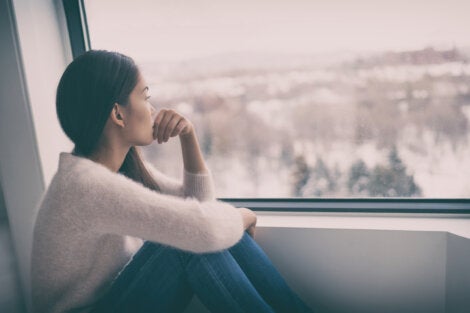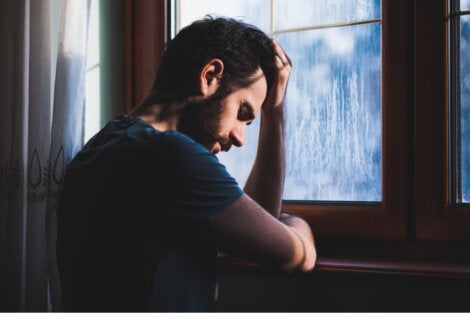Do Cloudy Days Make You Sad?

Are you one of those people who always notices changes in the weather? Do cloudy days put you in a bad mood? Don’t worry, you’re not alone. A lot of people feel sad on gray, dark days. This phenomenon has both a biological and a psychological explanation.
It’s important to clarify that not everyone experiences these weather-related mood changes. Some people enjoy rainy days, lower temperatures, and the lifestyle that this kind of climate requires. For other people, however, autumn and winter are difficult months that pose significant emotional challenges.

Why do cloudy days make you sad?
Neurobiology
From a biological standpoint, remember that the body functions according to circadian rhythms, which regulate your sleep cycles. We could say that the body synchronizes itself every day based on the sunlight it receives.
More light is a signal to your body that a new day is starting. On the contrary, less light tells your body to prepare for the end of the day and rest. Also, two important substances play a key role in this process:
- Melatonin is found in your body in different concentrations based on how much or how little sunlight your body gets. When it gets dark outside, your body releases more melatonin, which relaxes you and makes you sleepy. Your body temperature drops and prepares for sleep. Grey, cloudy days with little sunlight trigger the same process. That’s why you feel apathetic and listless. Your body is preparing for bed.
- Serotonin is the happiness neurotransmitter. Its presence activates you, improves your mood, and makes you feel social. It also helps reduce the number of negative thoughts that you might have. However, a lack of sunlight significantly lowers serotonin levels. As a result, you’re more likely to feel sad, nostalgic, and blue.
Psychology
All that being said, these chemical changes aren’t directly responsible for feeling sad on cloudy days. In fact, it’s those changes combined with the cognitive and behavioral changes that you experience. In other words, your thoughts and behaviors sustain the sadness and apathy you feel.
People who experience mood changes as a result of the weather tend to turn inward on cloudy, cold, and rainy days. They become less active, more solitary, and more focused on dysfunctional thought patterns. They significantly reduce their social contact and their inner dialogue turns pessimistic.
Seasonal depression
The people who suffer from seasonal depression experience, to some degree, the typical symptoms of a depressive disorder during the fall and winter. Fortunately, the symptoms disappear in the spring and summer.
During the greyest months, when cloudy days are the most common, they feel sad and listless, have trouble sleeping, and their appetite changes. Individuals with seasonal depression feel pessimistic and hopeless about the future. They might also feel irritable and feed thoughts of guilt and blame.
One common treatment for seasonal depression is phototherapy. Phototherapy is exposure to bright, artificial light for a certain amount of time every day to minimize the effect of a lack of sunlight. Although this is helpful for some people, it doesn’t always work.

What to do if cloudy days make you sad
Since you can’t change the weather, you’ll have to focus on the cognitive and behavioral factors that are under your control. If you’ve noticed that you feel sad on grey days, make a conscious effort not to fall prey to apathy and pessimism.
Try to overcome your lethargy and get moving. Do things that you enjoy, both inside and outside the house. Organize gatherings with family and friends or spend more time on a hobby that you’ve let fall by the wayside. You should also pay attention to your thoughts and intervene when you notice they’re turning negative. Above all, if you feel like you can’t do it alone, ask for help.
All cited sources were thoroughly reviewed by our team to ensure their quality, reliability, currency, and validity. The bibliography of this article was considered reliable and of academic or scientific accuracy.
- Gatón Moreno, M. A., González Torres, M. Á., & Gaviria, M. (2015). Trastornos afectivos estacionales,” winter blues”. Revista de la Asociación Española de Neuropsiquiatría, 35(126), 367-380.
- Golden, R. N., Gaynes, B. N., Ekstrom, R. D., Hamer, R. M., Jacobsen, F. M., Suppes, T., … & Nemeroff, C. B. (2005). The efficacy of light therapy in the treatment of mood disorders: a review and meta-analysis of the evidence. American Journal of Psychiatry, 162(4), 656-662.
This text is provided for informational purposes only and does not replace consultation with a professional. If in doubt, consult your specialist.








